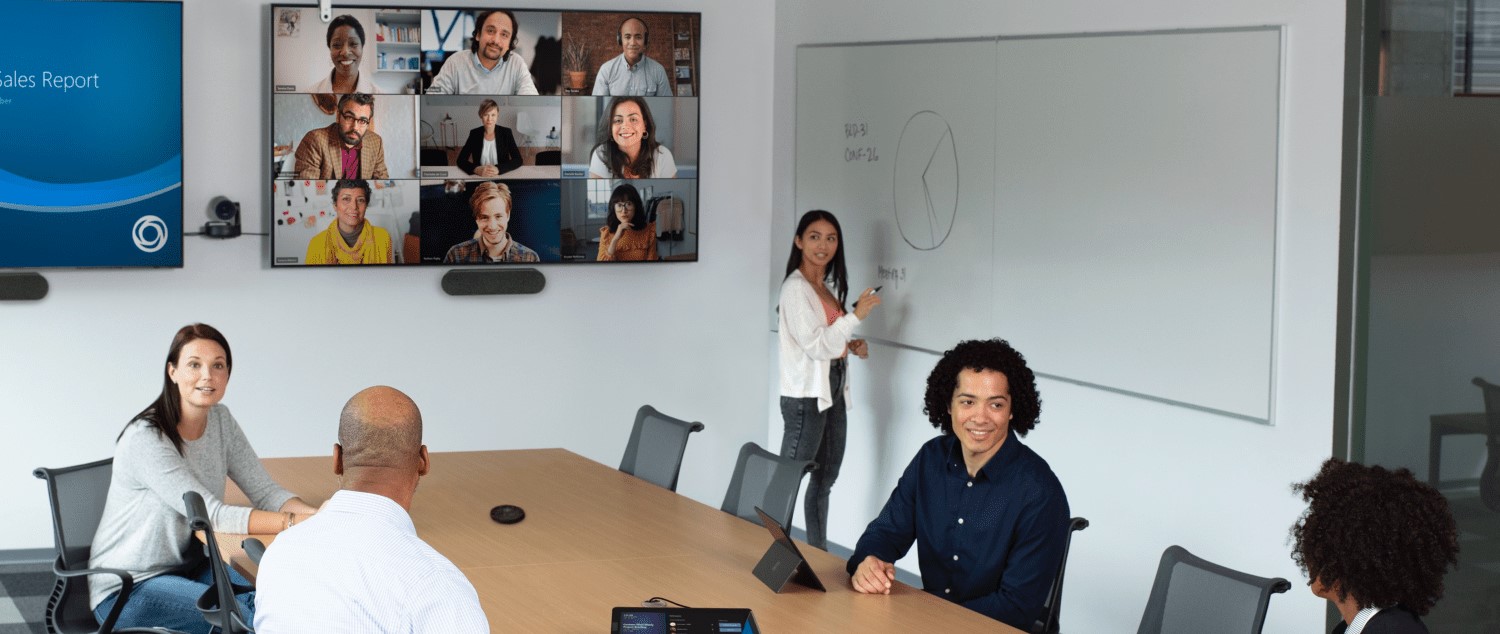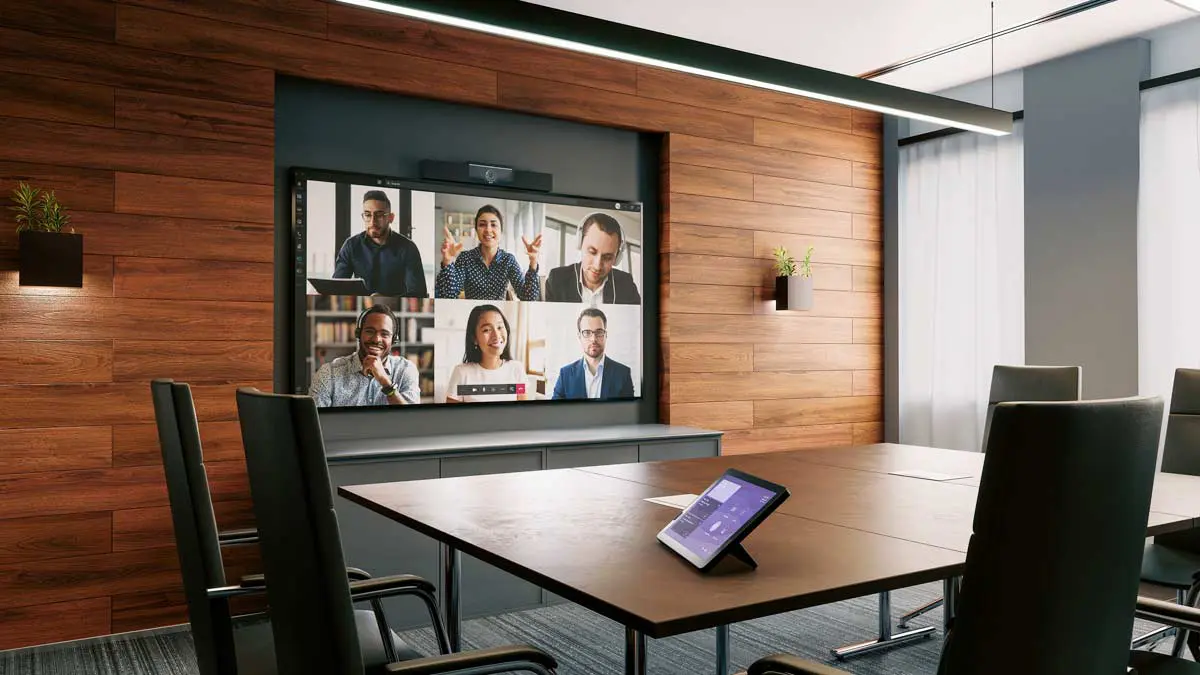Whether it’s a meeting room, a break-out space, or a board room – the modern-day conference room has evolved to become an interesting space. It’s no longer a plain and simple room where people sit and talk. There are a host of different features that enhance the experience of those working within. How have these rooms changed over time and what does that mean for audio-visual technology and its applications? Let’s discuss this especially in the context of the rush towards hybrid working where not everyone works from the office.
They’re Often Smaller
Today’s conference room is often just big enough to fit around six people per meeting. They are usually around 150 square feet. These are designed for small groups so that discussions can be more intimate. It’s also easier to get work done. These rooms are also called huddle rooms. Most video meetings with a mix of onsite and remote participants take place in rooms like this. Most organizations today have multiple huddle rooms. These spaces have specific requirements that differentiate them from larger conference rooms.
No Walls
Also called ‘open concept’ rooms, these spaces don’t have individual closed-door offices. Many times, you won’t see a cubicle in sight. There will be tools such as computers, phones, and paper. Sometimes, there may be walls but they’ll be encased in glass. The thought behind this is to boost engagement, collaboration, health, and employee satisfaction. But they do have their issues, such as less privacy, network issues, ambient noise, and problems with conferencing.
VC Screens
Each workspace and meeting room is equipped with a state-of-the-art conferencing system. Each area must be enabled by video. This proved to be especially important now when teams comprise people working remotely as well as from the office. Without a high-quality video conferencing set-up, office communications and employee collaboration suffered tremendously. Now, with the future of working looking to stay in a hybrid setup, more office rooms will have to invest in good quality AV installations.
Flexible
Even conference rooms need to be flexible today to accommodate varying numbers of participants joining across different modes. Employees need to move from work station to work station with ease. They need to switch from desktops to laptops, landlines to cell phones, and more. These transitions must be aided by the design of the offices. Technology must also allow employees to move about with comfort without experiencing disruptions in their workflow as they move from one station to the other.
The Effect on the AV Solutions
1. The Right VC Camera Options
As the office sizes have decreased and all these other factors have emerged, video cameras must be evaluated differently as well. Study the field of view and the overall size needed. In smaller spaces, people will huddle around the camera and mic. Therefore, you must use a wide-angle lens so that everyone can be seen. You could also add pan/tilt abilities to enhance the camera’s field of sight. You should also use smaller cameras which are relatively unobtrusive. It should have built-in speakers and mics, but those don’t need to be loud. Try a compact, all-in-one conference camera with built-in speakers.
2. High-Quality Sound
Figuring out the sound also becomes important as you can no longer suffice with a simple webcam. Those speakers are insufficient for an important meeting where people will want to discuss and debate ideas. Get high-quality solutions with optimized audio components. That way, everyone in the meeting will be heard and they’ll be able to hear as well. If the meeting is in an open area, it’s even more important for sufficient audio units so that they can cancel out background noise.
3. Managing the Equipment
As there are now multiple meeting rooms such as these in any given organization, you’ll need a way to track the status of all the hardware devices and software applications in the rooms. Many organizations want a new breed of conference cameras. These are called video bars and are standalone devices that are directly attached to the room’s monitor. They run the cloud video service on their OS. These are easy to install and manage. They’re also easier to update. AI and analytics are gaining traction for room management.
4. Proactively Resolving Technical Issues
You should be able to check the status of the technology in the room remotely. That would help keep meetings uninterrupted. Using the right software, you’ll be able to discover the trouble spots before the employee’s call. Use applications that are easy to read, clear, and will update you on the status of all the rooms. Try to synchronize the software so that they remotely update as well. That way, you’ll be able to troubleshoot any issues remotely.
5. Creating Simpler Employee Experiences
In the end, you have to create simple and time-saving experiences for the employees. They want easy and intuitive tools that are designed with their needs in mind. That will boost user adoption rates and allow employees to be flexible. Use products that are easy for employees to connect to and use instantly. That will ensure the best possible end-user experience for them, regardless of the conference room’s structure. Following the above pointers would help them be more agile.
Use Surge+
Solutions such as Surge+ are especially useful in such situations. It’s a cloud-based video communications platform-led solution that lets your team have a physical presence across all their locations. It allows users to create and deploy thousands of unique links that can be placed anywhere. Everything can be scanned with a mobile. Surge+Jump technology allows users to place tablet screens across locations, which enables a high-quality flow of information. This tech helps employees move at lightning-fast speeds with the required access to support too.
Ensure your modern conference room is equipped with the right AV tech to streamline your work and help your employees perform optimally, no matter where the teams are located. Let us help you!



